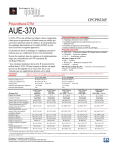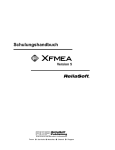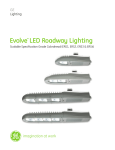Download GE ERX1 Whitepapers
Transcript
Advancements in LED Technology Advancements in LED (Light Emitting Diode) technology have made this source an attractive alternative to traditional light sources in a variety of applications. One such application is outdoor fixtures. This segment includes roadway and decorative street lighting, as well as general area lighting traditionally occupied by discharge light sources. In comparison to historic technologies (such as high pressure sodium and metal halide), today’s outdoor LED lighting fixtures can provide significant energy savings over their useful life. Another advantage is the long lifetime of today’s LED fixtures. Overall system reliability is comprised of several key subsystems and their components: the electrical subsystem, the optical subsystem and the outer enclosure. A simplified block diagram is shown below as an example to illustrate the relationship between these subsystems and their corresponding components. This paper addresses the reliability of GE’s outdoor LED lighting systems through examples of rigorous testing and reliability modeling, resulting from GE’s deep technical experience as one of the world’s largest LED systems companies. Mechanical Enclosure & Finish Subsystem Electrical Subsystem Optical Subsystem Driver PCB TVSS LEDs Reflector Wiring/Interconnects Seals/Gaskets Fuses Lens Control System Mounting Subsystem Figure 1: Simplified block diagram of outdoor LED system Figure 2: Open view of roadway fixture Reliability definitions The reliability bathtub curve is often used to depict the expected failure rate of a family of products over time. This model is comprised of three segments: infant mortality, useful life and wearout, as illustrated in Figure 3. Product “useful life” Failure Rate Approximate constant failure rate Product “wearout” Increasing failure rate “infant mortality” Decreasing failure rate Time Figure 3: Example of reliability bathtub curve Infant mortality is an initial period of failures usually resulting from manufacturing defects or quality excursions, and has a decreasing failure rate over a relatively short time frame. Product useful life is shown as the bottom portion of the bathtub curve. It is a period of random failures with a nearly constant failure rate. The weakest component in any system will determine the duration of this portion of the curve. At the end of useful life, wearout failure modes, such as fatigue and material depletion, will cause the failure rate to increase with time. This final segment of the curve is called wearout. Reliability during useful life is often a focus when considering products for a specific application. In the case of GE outdoor LED systems, an exponential distribution may be applied to model system reliability. Reliability values are often requested in the form of an MTBF (Mean Time Between Failures) value. MTBF is often misunderstood since it is expressed as a time value, but more accurately defines the failure rate during the useful life of the product. The relationship is illustrated below, where λ is the failure rate with units of hrs-1. It is important to note that this failure rate is valid only during the useful life portion of the bathtub curve where the failure rate is relatively constant. When the failure rate begins to increase, a product has entered wearout and a different mathematical model is needed to represent this behavior. For this reason, it is important to understand when wearout failure modes begin. Both component-level and full-system testing are utilized by GE Lighting engineers to understand and accurately model the reliability of outdoor LED systems. GE reliability philosophy At GE, the Design for Reliability (DFR) process is key to any product’s development cycle. For this reason, GE maintains a corporate-level reliability program to train and certify GE engineers in the important DFR tools and processes. Practitioner and Expert certifications are attainable, with the latter including an additional external accreditation. These certified professionals carry their reliability toolboxes across the GE businesses, driving a culture of education and best practice sharing. GE Lighting leverages the expertise of its certified Reliability Practitioners and Experts to drive rigor in its internal DFR process. This multistep approach incorporates a variety of design, analysis and test methods to deliver robust and reliable LED systems. GE’s DFR process begins by establishing the reliability goals for the product. These goals are based on a variety of inputs, including benchmarking activities, application considerations, customer expectations and warranty requirements. Engineers then analyze the system by developing Functional Block Diagrams (FBDs). These diagrams help engineers identify the critical subsystems and components in the system and allocate the appropriate reliability targets. From there, design teams complete an FMEA (Failure Modes and Effects Analysis) and Parameter Diagram (P-diagram). The FMEA is a structured analysis that surfaces potential failure modes in a system, while the P-diagram highlights key inputs, noise variables and control parameters that affect the system. Both tools help engineers design robust reliability test plans focused on the critical system elements and most likely failure modes. These test plans often include both Reliability Growth Testing (RGT) and Reliability Demonstration Testing (RDT). RGT is used early in the product design cycle to identify potential weak points or latent defects in a design. This allows engineers to implement corrective actions or design improvements to make the product more robust. When the design is finalized, RDT is used to validate the specified reliability goals for the product. This process is illustrated in Figure 4. Establish reliability goals • • • • • Reliability Growth Testing Benchmarking Application considerations Market surveys Customer expectations Warranty requirements • Develop & execute test plan • Analyze results Reliability gap analysis Design improvements (as needed) • Conduct FMEAs • Develop P-diagrams • Perform initial life predictions Product-level reliability requirements • Develop FBDs • Identify critical subsystems and components • Allocate reliability targets Figure 4: DFR flow diagram Specified robustness targets met Reliability Demonstration Testing • Develop & execute test plan • Analyze results Specified reliability targets demonstrated GE reliability testing As already stated, there are several key contributors to outdoor LED system reliability. Each of these contributing factors is scrutinized both individually and together at the system level to ensure the acceptability of overall system performance and reliability. Examples of this approach are highlighted in the next several paragraphs. Electronic drivers Electronic driver reliability begins with a series of predictive models using tools such as those in Reliacore’s Relex Reliability Studio or Reliasoft’s® Lambda Predict®. These models function as design tools used for predicting failure rates based on reliability prediction standards such as Bellcore/Telcordia and MIL-HDBK-217F as two examples. Engineers use these tools to make initial reliability estimates of a design, identify potential weak points, and evaluate the system impact when components or application conditions are changed. During the design phase, engineers evaluate tradeoffs and compare model results to the specified project requirements to select the optimal design for fabrication and testing. Drivers are required to pass a variety of well-defined testing requirements before entering service in GE LED systems. In addition to standard reliability life testing, accelerated test methods, robustness testing, surge immunity and EMI testing are employed. ALT (Accelerated Life Test) utilizes elevated stress conditions to more quickly estimate performance and life at lower nominal conditions by fitting the output data to a statistical model. Common acceleration factors include temperature, humidity and power cycle testing. HALT (Highly Accelerated Life Testing) includes a series of progressive steps with wide-ranging temperatures, rapid thermal cycling, multi-axis vibration testing, power cycling and other product-specific conditions. This testing is used to determine the operation and destruct limits of the product. STRIFE, or Stress Plus Life testing, is also used early in the development cycle to draw out potential design or manufacturing weaknesses. STRIFE, or Stress Plus Life testing, is also used early in the development cycle to draw out potential design or manufacturing weaknesses. During testing, units are put through high- and low-temperature cycles over a period of time defined by the industry standard model for fatigue-induced solder joint failures (known as the Norris-Landzberg equation). DME (Design Margin Evaluation) is a qualitative reliability tool that measures the margin between design strength of a unit and key environmental stressors such as ambient temperature and incoming line voltage. Results can be used to improve the margin of strength of a given design, as well as to highlight potential design weaknesses or manufacturing flaws. Test methods such as HALT and DME are typically used as Reliability Growth Tests. When used early in product design, engineers are able to identify potential failure modes and then implement corrective actions or design changes to make the product more robust. Life testing or ALT methods may then be applied as Reliability Demonstration Tests to validate specified product reliability targets. LEDs Component-level qualification testing is performed on any new LED to validate manufacturer claims and provide long-term reliability data under specified conditions. Such reliability testing includes thermal shock, powered temperature cycling and life testing under extreme temperature and humidity conditions. Optics The optics used in GE outdoor LED systems undergo a series of thermal soak, thermal fatigue and water emersion testing to ensure material robustness, even under elevated stress conditions. This provides confidence across a broad range of application conditions, including temperature excursions in the field. Mechanical enclosure Fixture-level vibration testing is used to evaluate the mechanical reliability of the system by simulating conditions that may be encountered during service. Examples include vibration induced by traffic, wind, ground disturbances, shipping and handling, and accidental impact. Minimum testing of 100,000 cycles per axis for three axes is designed to simulate normal fatigue conditions over the course of an outdoor fixture’s life, and is in line with ANSI C136.31. Additionally, enclosures undergo ingress protection (per ANSI C136.25), salt fog testing (per ASTM B117 and D1654) and QUV testing on the paint system (per ASTM G154 and D523). These accelerated tests are designed to ensure durability under expected environmental conditions over the product’s lifetime. Figure 5: G E’s Evolve™ LED Roadway Scalable Cobrahead Full system reliability testing GE outdoor LED fixtures also undergo full system reliability testing at nominal and elevated temperatures to ensure robust system-level reliability. This testing also highlights any potentially harmful interactions among the subsystems and their components, reducing the likelihood of early life failures. This testing continues even after products enter the field, providing a valuable database of long-term performance and reliability information to further support product claims. To date, GE outdoor LED systems have accumulated more than 1.4 million unit-hours of system-level reliability testing. GE outdoor LED system reliability In addition to a significant internal testing database, GE Lighting’s large, global installed base of outdoor LED systems provides engineers with valuable field data across a broad range of application conditions. This feedback loop is an essential part of GE’s DFR process, as it allows engineers to more accurately design, model and test systems based on realistic application conditions and incorporate lessons learned during development of next-generation products. This approach of applying reliability tools and practices early in product design, combined with rigorous internal testing and active feedback from the field, allows GE Lighting to confidently deliver outdoor LED systems with world-class robustness and reliability. For more information, please visit gelighting.com. © GE 2013 OLP-3070 2/2014











![[17] User`s Manual ver. 2.0.2](http://vs1.manualzilla.com/store/data/005765389_1-e376d351ef2708f30fcfdc5f98b9ba18-150x150.png)



